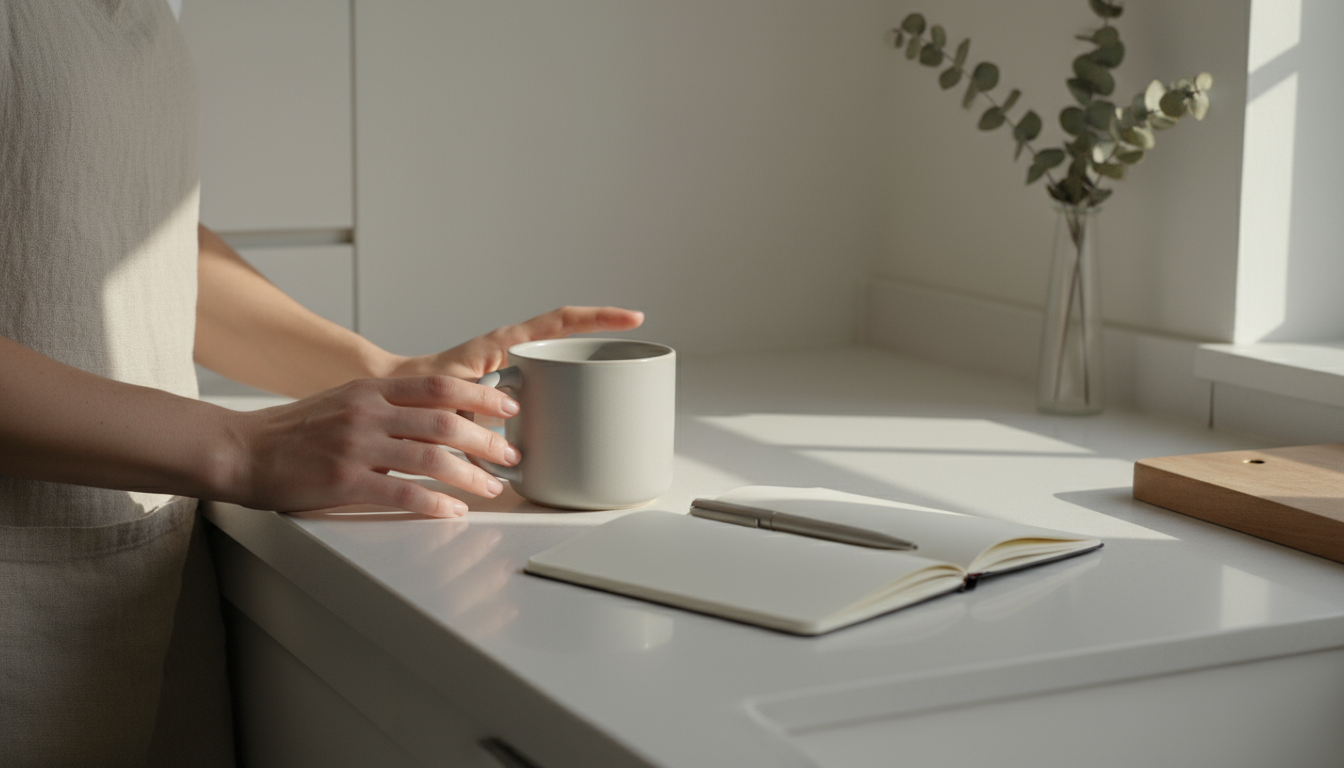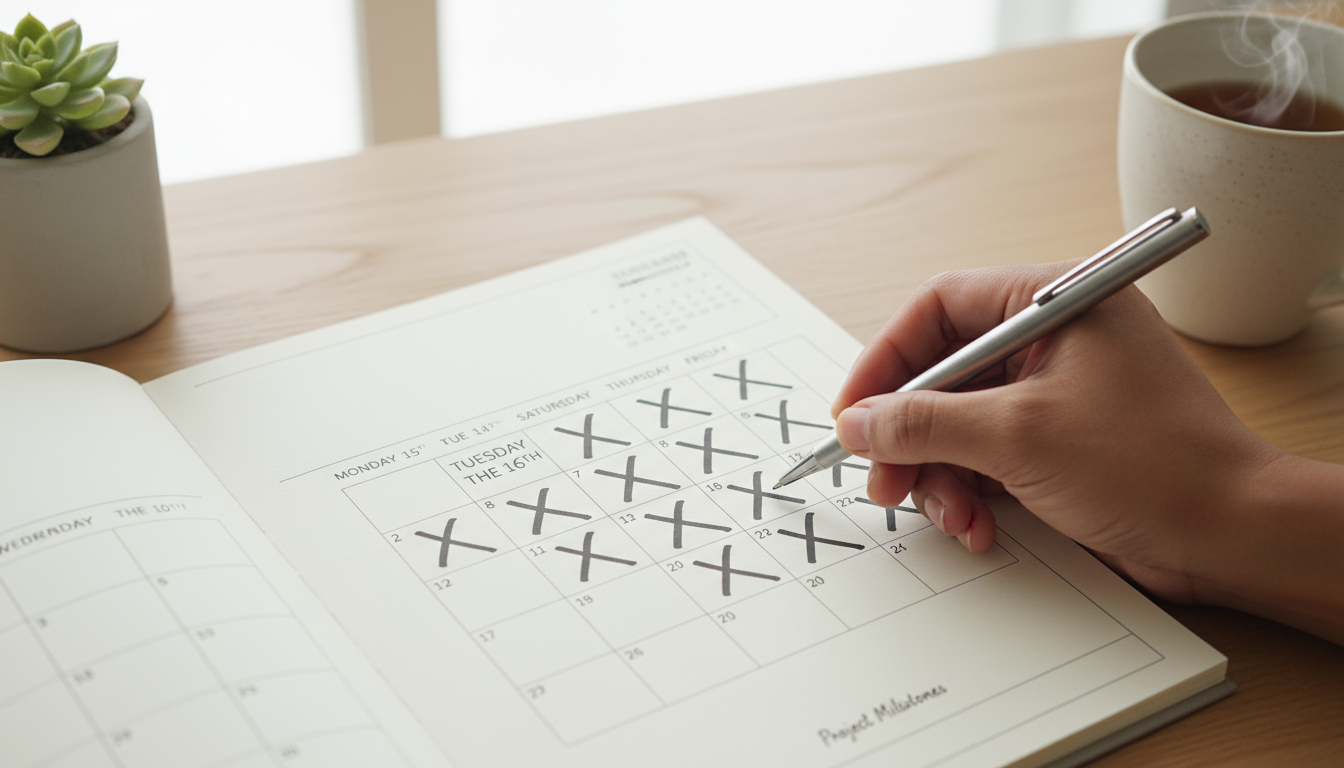
You’ve made the decision. This is the year. You’re going to meditate every morning, read a book a week, start a journaling practice, and finally learn to cook healthy meals. You buy the gear, download the apps, and clear your schedule. For three glorious days, you are the picture of discipline. On day four, you oversleep. On day five, an urgent work project derails your evening. By the end of the week, your beautiful new routine is a distant memory, another failed attempt filed away with a quiet sigh of resignation.
If this scenario feels painfully familiar, you are not alone. It’s not a failure of character or a lack of desire. The problem is the approach. We often treat habit building like a sprint, relying on a finite and fickle resource: willpower. Especially for those of us living and working in busy urban environments, willpower is a currency we spend all day long. From choosing a healthy lunch over a convenient pastry, to ignoring the ping of a new email while on a deadline, to navigating a crowded commute, every decision chips away at our resolve. By the time we get home, our willpower reserves are often running on empty, making the idea of a demanding new habit feel less like an opportunity for growth and more like another exhausting chore.
The traditional model of habit formation—going from zero to sixty with sheer grit—is fundamentally broken for the modern world. It demands too much energy, too soon. It sets us up for failure and reinforces the damaging belief that we are “just not disciplined enough.” But what if there were a different way? A gentler, more sustainable path to creating the life you want?
There is. It’s a beautifully simple principle that sidesteps the need for herculean willpower and instead focuses on the most critical part of any new behavior: starting. It’s called the 2-minute rule, and it’s more than just a productivity hack. It’s a profound shift in how you approach personal change. It’s a philosophy that honors your energy levels, works with your brain’s natural wiring, and makes consistency not just possible, but nearly effortless. In this guide, we’ll explore why the two minute rule for habits is the secret to building a system of durable, burnout-proof behaviors. We will unpack the science behind it, design a practical framework you can use today, and show you how this tiny change can lead to a remarkable transformation. Forget the grand gestures and all-or-nothing sprints. The future you want is built in two-minute increments.
📚 Table of Contents
- The Hidden Blueprint: Understanding Your Brain’s Habit Engine
- Designing Your 2-Minute System for Lasting Change
- Step 1: Define Your Minimum Viable Action
- Step 2: Conduct a Friction Audit
- Step 3: Engineer Your Cues with Habit Stacking
- Step 4: Introduce Gentle Accountability
- Navigating the Inevitable: Safeguards for Your Journey
- Plan for Relapse Before It Happens
- Understand Streak Psychology Without Becoming Its Prisoner
- Practice the Art of Resetting Without Shame
- The 2-Minute Rule in Action: Two Sample Routines
- Frequently Asked Questions About the 2-Minute Rule
- 1. How long does it really take to form a new habit?
- 2. What should I do when I travel or my routine is completely disrupted?
- 3. I’ve been doing the 2-minute version for weeks. When and how do I expand it?
- 4. Can I use the 2-minute rule to start multiple new habits at once?
- 5. This seems great for small habits, but what about huge goals like writing a book or starting a business?
- Your First Step: A 7-Day Plan to Begin
The Hidden Blueprint: Understanding Your Brain’s Habit Engine
Before we can effectively build new habits, we need to understand the machinery we’re working with. Our brains are incredibly efficient, and a huge part of that efficiency comes from automating regular behaviors. Habits are, in essence, the brain’s shortcuts. They are solutions to recurring problems in our environment that we’ve learned to perform without conscious thought. This automation process is governed by a simple neurological feedback system often called the habit loop.
Think of the habit loop as a three-part sequence. First, there’s the Cue. This is the trigger, the bit of information that tells your brain to go into automatic mode and which habit to use. It could be a time of day (7:00 AM), a location (your kitchen), a preceding event (finishing dinner), or an emotional state (feeling stressed). The cue is the starting pistol for the behavior.
Second, there’s the Action, also known as the routine or the behavior itself. This is the habit you perform, whether it’s brushing your teeth, checking your phone, or pouring a cup of coffee. It’s the part we tend to focus on most when we think about habit building.
Third, and arguably most important, is the Reward. This is the satisfying outcome that tells your brain, “Hey, this loop was worth remembering for the future.” The reward can be a physical sensation (the clean feeling of your teeth), an emotional payoff (the relief from boredom when you scroll social media), or a cognitive benefit (the jolt of caffeine). This reward solidifies the connection between the cue and the action, making it more likely you’ll repeat the behavior next time the cue appears. Understanding this Cue-Action-Reward cycle is the first step in learning how to design better habits for yourself.
But there’s a deeper layer to this. The most durable habits aren’t just tied to a reward; they are tied to our sense of self. This is the concept of identity-based habits. Many of us start with outcome-based goals. For example, “I want to run a marathon” (outcome) or “I want to lose 15 pounds” (outcome). The problem with this approach is that you are always working in opposition to your current identity until you reach that distant goal. You are a “non-runner” trying to run. You are an “unhealthy person” trying to eat better.
Identity-based habits flip the script. You start with who you wish to become. The goal is not to run a marathon; the goal is to become a runner. The goal is not to write a book; the goal is to become a writer. The focus shifts from what you want to achieve to who you want to be. Each action you take is no longer a chore on the way to a finish line, but a vote for the type of person you are. Every time you lace up your shoes and go for a jog, no matter how short, you are casting a vote for your identity as “a runner.” Every time you sit down and write one paragraph, you are reinforcing your identity as “a writer.”
This is where the power of the 2-minute rule truly shines. A grand, one-hour workout might feel overwhelming and inconsistent with your current identity. But can you be the type of person who puts on their running shoes and walks around the block for two minutes? Absolutely. That small, manageable action is a powerful affirmation of your new identity. It’s a tiny victory that tells your brain, “See? This is who I am now.” The 2-minute rule isn’t about the immediate result of the action; it’s about mastering the art of showing up and casting a vote for the person you are becoming. It’s the engine that makes identity-based habits work.

Designing Your 2-Minute System for Lasting Change
Understanding the theory is one thing; putting it into practice is another. The beauty of the 2 minute rule is its simplicity and adaptability. It’s not a rigid program but a flexible design principle for any new habit you want to introduce into your life. Let’s break down how to design a system that works for you, not against you.

Step 1: Define Your Minimum Viable Action
The core of this entire strategy is the minimum viable action. This is the absolute smallest, easiest version of your desired habit—an action so simple it’s almost impossible not to do. The rule of thumb is that it should take less than two minutes to complete. The goal here is not to achieve your ultimate ambition in one go; the goal is to make the act of starting frictionless. We are optimizing for consistency, not intensity.
Let’s look at some common goals and their 2-minute counterparts:
Instead of: “Read 30 pages every night.”
Try: “Open a book and read one sentence.”
Instead of: “Do a 30-minute yoga session every morning.”
Try: “Roll out my yoga mat.”
Instead of: “Write 1,000 words for my novel.”
Try: “Open my document and write one sentence.”
Instead of: “Tidy the entire house.”
Try: “Put one item away in its proper place.”
This may seem ridiculously small, and that’s the point. You are not trying to impress anyone. You are trying to build momentum and establish an identity. Anyone can roll out a yoga mat, even on their most tired, unmotivated day. By doing so, you master the crucial first step. You are not allowed to do more for the first week or two. Your only job is to show up and perform the 2-minute version. Once the habit of starting is ingrained, you can naturally extend the duration when you feel ready. But the commitment remains to the first two minutes.

Step 2: Conduct a Friction Audit
Friction is anything that stands between you and taking action. It’s the effort, time, or decision-making required to start a behavior. Our brains are wired to follow the path of least resistance. To build good habits, we must decrease the friction associated with them. To break bad habits, we must increase it. This is your friction audit.
To decrease friction for a desired habit, ask yourself: “How can I make this ridiculously easy to start?” If your goal is to drink more water, fill up a water bottle the night before and place it on your bedside table. If you want to go for a run in the morning, lay out your running clothes, shoes, and socks before you go to bed. If you want to journal, leave your notebook and a pen open on your desk. Each of these actions removes a decision point and a small barrier, making the 2-minute action even easier to perform.

Step 3: Engineer Your Cues with Habit Stacking
One of the best ways to create a powerful cue for a new habit is to link it to an existing one. This technique is called habit stacking. Your current daily routine is already filled with dozens of ingrained habits: waking up, brushing your teeth, making coffee, commuting. These are solid anchors to which you can attach your new 2-minute habit.
The formula is simple: “After I [CURRENT HABIT], I will [NEW 2-MINUTE HABIT].”
For example:
“After I pour my morning cup of coffee, I will sit and meditate for two minutes.”
“After I take off my work shoes, I will change into my workout clothes.”
“After I brush my teeth at night, I will open my journal and write one thing I’m grateful for.”
The existing habit acts as a reliable, automatic trigger for the new one. You don’t need to set a reminder or rely on memory; the cue is built directly into the flow of your day. This is how you design an environment that nudges you toward your goals instead of away from them.

Step 4: Introduce Gentle Accountability
Accountability doesn’t have to mean intense pressure or public declarations. It can be a simple, private system that reinforces your commitment. A habit tracker is a perfect example. Get a calendar or a notebook and make a big, satisfying ‘X’ on each day you complete your 2-minute habit. This creates a visual representation of your progress and taps into our natural desire to not “break the chain.” The reward of making that mark can be enough to solidify the habit loop. Alternatively, you could have an accountability partner—a friend you text each day with a simple “Done.” The key is to make the accountability system as simple and low-friction as the habit itself.

Navigating the Inevitable: Safeguards for Your Journey
Even with the best-designed system, life happens. There will be days when you are sick, traveling, or overwhelmed. A rigid, all-or-nothing mindset sets you up for a catastrophic failure the moment you miss a single day. A resilient system, however, plans for imperfection. It builds in safeguards that allow you to stumble without falling, ensuring that one off-day doesn’t derail your entire journey of habit building.

Plan for Relapse Before It Happens
The most successful people are not those who never fail, but those who get back on track quickly. One of the most powerful rules for habit formation is this: Never miss twice. Missing one day is an accident. Missing two days is the beginning of a new, unwanted habit. Life will inevitably cause you to miss a day. The real test is what you do the day after. Your entire focus should be on not letting that single miss turn into a streak of misses.
Create a simple “if-then” plan for likely disruptions. For instance, “If I have to work late and miss my evening reading, then I will wake up and read one page before I check my phone in the morning.” Or, “If I am traveling and can’t do my normal 2-minute floor stretch, then I will do a 2-minute standing stretch in my hotel room.” Having a pre-planned response removes the need for in-the-moment decision making when you’re already tired or stressed. It gives you an immediate, easy path back to consistency.

Understand Streak Psychology Without Becoming Its Prisoner
Keeping a streak, often visualized with a habit tracker, can be incredibly motivating. Watching the chain of ‘X’s grow longer provides a powerful, tangible reward that strengthens the habit loop. It provides evidence that you are, in fact, becoming the kind of person who shows up consistently. However, for some personalities, an unbroken streak can become a source of anxiety. The fear of breaking a 100-day streak can be so paralyzing that it leads to burnout or avoidance.
It’s crucial to hold the streak lightly. The streak is a tool to serve you, not a master to be served. Its purpose is to motivate, not to judge. If you do break a streak, it does not erase the 99 days of progress you made. It does not mean you’ve failed. It is simply a piece of data. Your identity is not “a person with a 100-day streak.” Your identity is “a person who meditates.” Breaking the streak doesn’t change that. The most important action is always the next one. Acknowledge the break without judgment and begin a new streak of one, starting now.

Practice the Art of Resetting Without Shame
Shame is the most destructive emotion in the process of behavior change. When we miss a day and then layer on feelings of guilt, frustration, and self-criticism, we make it exponentially harder to start again. That negative emotional state becomes associated with the habit itself, creating massive friction. The next time you think about the habit, you don’t just have to overcome the inertia of starting; you also have to overcome the dread of potential failure and the memory of feeling bad about yourself.
The solution is to practice self-compassion. When you miss a day, treat yourself as you would a good friend who is trying their best. Acknowledge that it happened. Be curious, not critical. Ask, “What got in the way? Was my 2-minute action still too big? Was my cue unreliable?” Use it as a learning opportunity to refine your system. Then, remind yourself of your new identity. “I am a writer, and writers sometimes have off-days. Today, I will write one sentence.” Reset your focus to the present moment and the very next action. By decoupling your self-worth from your daily performance, you create the psychological safety needed to persist through challenges. This compassionate approach is fundamental to building habits that last a lifetime.

The 2-Minute Rule in Action: Two Sample Routines
Theory and principles are helpful, but seeing how they come together in a practical, daily routine can make all the difference. Let’s walk through two worked examples—an evening wind-down and a morning focus primer—to illustrate how to apply the concepts of the 2-minute rule, habit stacking, and friction reduction in a real-world context.

Example 1: The Evening Wind-Down Routine
The Goal: To stop mindless phone scrolling before bed, read more, and get better quality sleep. The desired identity is “I am a calm and intentional person who prioritizes rest.”
The Old, Failed Approach: A rigid rule like “No phone after 9 PM, must read for 30 minutes, and be in bed by 10 PM sharp.” This often failed after a long day when willpower was low, and the pull of the phone’s easy dopamine hits was too strong.
The 2-Minute Redesign:
First, we identify a solid anchor habit. For most people, brushing their teeth is an automatic, non-negotiable part of their evening. This will be our primary cue. The habit stack becomes: “After I brush my teeth, I will begin my wind-down.”
Next, we conduct a friction audit. The biggest friction for reading is the effort of choosing a book and starting. The biggest temptation is the phone. So, we increase friction for the unwanted habit and decrease it for the desired one. An hour before bed, the phone gets plugged in to charge in another room, like the kitchen. This single act makes it significantly harder to mindlessly grab it from the nightstand. At the same time, a book is placed on the pillow. It’s open to the correct page with a bookmark in place. The friction to start reading is now near zero.
Finally, we define the minimum viable action. The rule isn’t “read for 30 minutes.” The rule is: “After I brush my teeth, I will get into bed, pick up the book on my pillow, and read one page.” That’s it. It’s a two-minute commitment. Of course, on many nights, one page will turn into three, or ten, or a whole chapter. But on a tired, stressful night, the only requirement is to read that single page. This action casts a powerful vote for the identity of being a “person who reads” and a “person who winds down intentionally,” without demanding an ounce of willpower.

Example 2: The Morning Focus Primer
The Goal: To start the workday with clarity and intention, rather than reactive stress from immediately checking email. The desired identity is “I am a focused person who controls their attention.”
The Old, Failed Approach: “I will wake up at 6 AM, meditate for 20 minutes, journal for 15 minutes, and plan my entire day before even looking at my phone.” This complex, hour-long routine is brittle and easily shattered by a late night or a snooze button.
The 2-Minute Redesign:
The anchor habit here is often making coffee or tea. It’s a reliable, ingrained morning ritual. The habit stack is: “After I start the coffee maker, I will begin my focus primer.”
For the friction audit, we identify the primary distraction: the phone. The rule is that the phone cannot be the first thing touched in the morning. It stays on the charger or in another room. To decrease friction for the desired habit, a small cushion or a specific chair is designated as the “meditation spot.” A notebook and pen are left open on the desk the night before, ready for the journaling component.
The minimum viable action is broken down. The commitment isn’t to a long, complex routine. It’s simply: “After the coffee starts brewing, I will sit on my cushion and take three deep breaths.” That’s the first 2-minute habit. The second part is: “While my coffee cools, I will open my notebook and write down my single most important task for the day.” This entire “focus primer” takes less than five minutes but completely changes the trajectory of the morning. It shifts the brain from a reactive mode (checking emails and notifications) to a proactive one. It’s a small win that reinforces the identity of being a focused, intentional person, setting a calm and purposeful tone for the rest of the day.

Frequently Asked Questions About the 2-Minute Rule
As you begin to implement this strategy, questions will naturally arise. Here are answers to some of the most common queries about using the two minute rule for habits to make meaningful, long-term change.
1. How long does it really take to form a new habit?
You have probably heard the common myth that it takes 21 days to form a habit. While a catchy number, research shows it’s much more variable. The time it takes for a behavior to become automatic depends heavily on the complexity of the habit, the environment, and the individual. Some studies suggest the average is closer to 66 days, with a wide range from 18 to 254 days. However, focusing on a specific number is counterproductive. It makes you feel like a failure if you don’t feel “automatic” by a certain date. The 2-minute rule encourages you to discard the timeline and focus on the process. The goal isn’t to reach an arbitrary finish line; the goal is to show up today. When you focus on making the habit as easy as possible to start, automaticity will become a natural byproduct of consistency, regardless of how long it takes.
2. What should I do when I travel or my routine is completely disrupted?
This is where the 2-minute rule is most valuable. A 30-minute workout, a one-hour writing session, or a complex cooking routine is often the first thing to be abandoned during travel. They are too rigid and location-dependent. Your 2-minute habit, however, is designed for resilience and portability. You might not have your yoga mat, but you can still do a 2-minute stretch on the hotel room floor. You might not have your journal, but you can open a notes app and write one sentence of gratitude. The key is to maintain the rhythm of the habit, even in a scaled-back form. By performing the tiny, 2-minute version, you are still casting a vote for your desired identity and maintaining your consistency. This makes it infinitely easier to ramp back up to your normal routine when you return home.
3. I’ve been doing the 2-minute version for weeks. When and how do I expand it?
The signal to expand a habit is not a date on the calendar, but a feeling in your gut. You should expand when the 2-minute version feels completely automatic, easy, and, most importantly, when you feel a genuine pull to do more. It should feel less like a chore you have to force and more like a desire you want to fulfill. When you roll out your yoga mat and think, “I actually feel like doing a few sun salutations,” that’s your cue. The expansion should also be gradual. Don’t jump from a 2-minute meditation to a 20-minute one. Try five minutes for a week. See how it feels. This process of “habit shaping” allows you to slowly increase the difficulty without shocking your system and reintroducing the friction you worked so hard to eliminate.
4. Can I use the 2-minute rule to start multiple new habits at once?
While it’s tempting to overhaul your life in one go, it’s generally more effective to focus on one, or at most two, new habits at a time. Each new habit, even a 2-minute one, requires a small amount of cognitive resources to track and implement. Trying to juggle five new habits can lead to decision fatigue and increase the odds that you’ll drop all of them. Pick the single habit that would have the most positive ripple effect in your life. Master the art of showing up for that one thing first. Once it feels ingrained and requires very little conscious effort, you can then “stack” another 2-minute habit into your routine. Slow, focused progress is far more durable than a frantic, scattered burst of effort.
5. This seems great for small habits, but what about huge goals like writing a book or starting a business?
The 2-minute rule is not just for small habits; it’s a gateway to achieving large goals. Every big goal is ultimately the sum of many small, consistent actions. No one writes a book in a single, heroic 12-hour session. A book is written one sentence, one paragraph, one page at a time. Use the 2-minute rule to master the art of starting the essential action. The goal is not “write a book.” The 2-minute habit is “open the document and write for two minutes.” For starting a business, the habit could be “spend two minutes each day researching one potential customer” or “spend two minutes outlining one part of the business plan.” The 2-minute rule neutralizes the procrastination and overwhelm that so often paralyze us in the face of massive goals. It gets you in the chair and in motion, and motion creates momentum.

Your First Step: A 7-Day Plan to Begin
We’ve covered the why and the how. We’ve explored the psychology, designed the system, and planned for setbacks. Now, the only thing left is to begin. The power of the 2 minute rule lies not in reading about it, but in doing it. The goal is to move from passive learning to active implementation. Forget about the next year or even the next month. Let’s focus on one week.
Your journey to durable, burnout-free habits starts with a single, simple action. Here is your roadmap for the next seven days. Don’t overthink it. Just follow these steps with a spirit of gentle curiosity and see what happens.
First, choose just one thing. Look at the areas of your life where you’d like to see change. Do you want more calm, better health, more creativity, a tidier space? Pick the one habit that feels most important or exciting to you right now. Resist the urge to pick three. We are starting with a single, focused effort.
Second, shrink it down. Take that habit and apply the 2-minute rule. What is the absolute, most ridiculously simple version of this behavior? “Go to the gym” becomes “Put on my running shoes.” “Meditate for 20 minutes” becomes “Sit on the cushion and close my eyes.” “Learn Spanish” becomes “Open my language app.” Write down your minimum viable action. This is your only goal for the week.
Third, pair it with a current habit. Where will this new action live in your day? Use the habit stacking formula: “After I [CURRENT HABIT], I will [NEW 2-MINUTE HABIT].” Maybe it’s, “After I hang up my coat from work, I will change into my gym clothes.” Or, “After I set my morning alarm at night, I will set out my journal and pen.” Make the cue as specific and obvious as possible.
Fourth, do it for seven days. Commit to showing up and performing your 2-minute habit every day for one week. That’s it. You are not allowed to do more, even if you feel like it. The purpose of this first week is not to see results; it is to practice the skill of consistency. Your only measure of success is: Did I show up and do my two minutes? Yes or no. Get a piece of paper and make a big ‘X’ for each successful day. Celebrate that small win.
This simple process is how real change begins. Not with a burst of unsustainable motivation, but with a quiet, consistent, and compassionate commitment to showing up. The 2-minute rule is more than just a technique for habit building; it’s an invitation to trust the process of small gains. It’s a way to prove to yourself, one tiny action at a time, that you are exactly the kind of person who can build the life they want. Start small. Start now.
Disclaimer: The information provided in this article is for educational and informational purposes only and is not intended as medical or psychological advice. It is not a substitute for professional advice from a qualified healthcare provider. Always seek the advice of your physician or other qualified health professional with any questions you may have regarding a medical condition or mental health concerns. For authoritative information, please consult resources such as the American Psychological Association or the National Institutes of Health.






